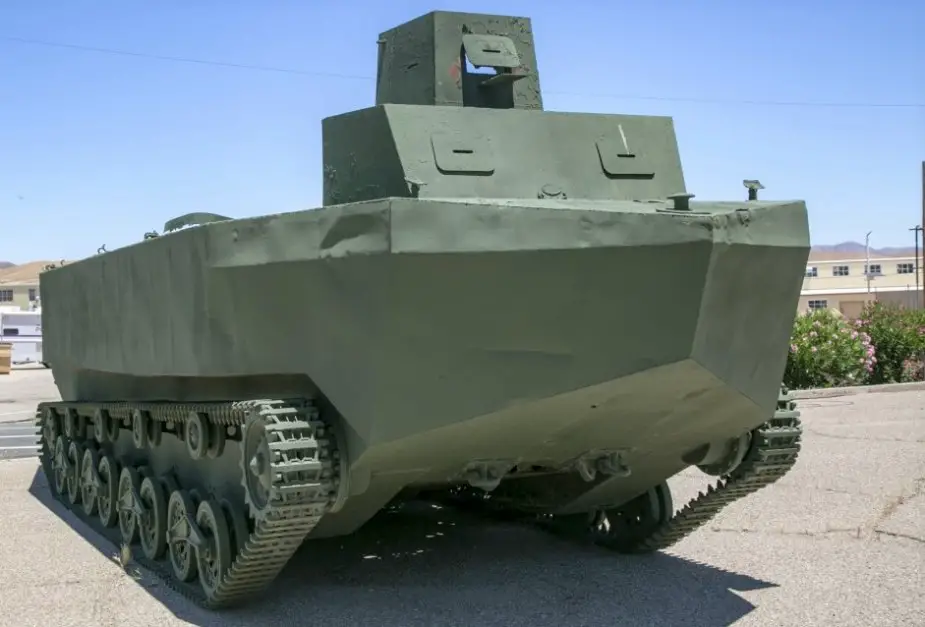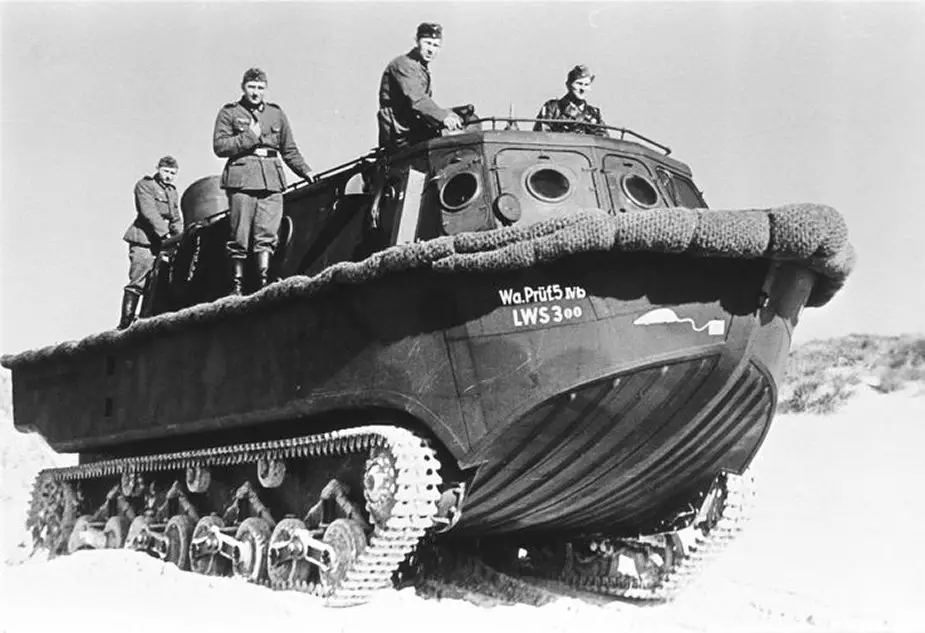Last Japanese Type 4 Ka-Tsu tracked amphibious vehicle housed at U.S. Marine Corps Logistics Base Barstow
Aside from its location in the Mojave desert, MCLB Barstow is a major storage and industrial facility. What makes MCLB Barstow really unique is that it is home to the only surviving Japanese Type 4 Ka-Tsu, a tracked vehicle developed by Mitsubishi Heavy Industries for the Imperial Japanese Navy in World War 2 to give it a ship-to-shore capability similar to the U.S. landing tracked vehicles (LVTs). Robert Jackson, Marine Corps Logistics Base Barstow, reports.
Follow Army Recognition on Google News at this link

The last survivor of only 49 Japanese Type 4 Ka-Tsus ever built (1944) is on display at U.S. Marine Corps Logistics Base Barstow, Calif. The Type 4s were never put into operation and were abandoned at Kure, Japan (Picture source: USMC/Robert Jackson)
Introduced in 1944, the 16-ton Ka-Tsu could carry up to 40 troops or four tons of cargo, plus a crew of five. Access to the cargo area was via six hatches in the top deck, so it was unable to carry a vehicle or large military pieces, unlike some U.S. LVTs (Landing Vehicle - Tracked). It was armed with two pedestal-mounted Type 93 13mm machine guns. Propulsion in the water was via two propellers that gave it a top speed of 5 knots, or 12 miles per hour.
According to nationalinterest.org, the Type 4 completed testing in March 1944 and was accepted into service. But by then, the Japanese Navy was looking to use the Type 4 offensively as it grew clear the Japanese home islands would soon come under attack. At first, the Japanese Navy considered using the Type 4 in a kamikaze role similar to it Kaiten manned torpedoes. But eventually, it instead decided to modify the Type 4 to carry two 450 millimeter Type 2 torpedoes mounted atop each side of its boxy hull. The U.S. Navy often anchored ships in shallow island lagoons that would be virtually impossible for Japanese submarines to penetrate. But the Type 4s could simply cross shallow reefs on their tracks.
Five large Japanese ‘cruiser” submarines were modified to carry two Ka-Tsus each for a planned raid on U.S. warships anchored at Majuro in the Marshall Islands. Seven smaller submarines would escort the tank-carrying subs into position, and then pick off American carriers as they tried to flee the carnage.
Lugging two 1,870-pound torpedoes left the Ka-Tsu unbalanced and underpowered, however. Moreover, the submarine branch hated the idea, accurately forecasting the Type 4’s engine compartment would flood while the submarine was submerged. Furthermore, it took 20 minutes to remove the Type 4’s watertight engine covers and start its engine, during which time the surfaced submarine would be visible to enemy radars and highly vulnerable to attack. The noisy, ponderous and lightly armored swimming tanks would have been sitting ducks to the small PT boats assigned nearby for base security.
So on May 3, 1944, a Combined Fleet notice announced “...it was discovered that the special Type 4 assault boat had performance defects such as the noisy engine, low speed, and caterpillar tracks breaking in sediment. It was judged that the May 12 operation (Operation Yu-Go) was impossible, and it was postponed.”
The Ka-Tsus which were already built never saw action and were later found abandoned after the war in Kure. Of the approximately 49 Ka-Tsu produced, only one has survived and is located here on MCLB Barstow. You can see the vehicle near the main gate on display with four other U.S. produced LTVs from World War II, Korean and Vietnam War eras.
The development of the U.S. LVTs is captivating. They initiated a long saga leading to the current AAV/Assault Amphibious Vehicle and the future ACV/Amphibious Combat Vehicle.
Army Recognition underlines the fact that the Ka-Tsu obviously benefited from a German predecessor designed before World War 2: the Landwasserschlepper (Land-Water-Tracked)

Landwasserschlepper in World War 2 (Picture source: German army)
The Landwasserschlepper
Ordered by the Heereswaffenamt in 1935 for use by German Army engineers, the Landwasserschlepper (or LWS) was intended as a lightweight river tug with some capacity to operate on land. Intended to aid river crossing and bridging operations, it was designed by Rheinmetall-Borsig of Düsseldorf. The hull was similar to that of a motor launch, resembling a tracked boat with twin rear-mounted tunnelled propellers and twin rudders. On land, it rode on steel-shod tracks with four bogies per side. By the autumn of 1940 three prototypes had been completed and were assigned to Tank Detachment 100 as part of Operation Sea Lion. It was intended to use them for pulling ashore unpowered assault barges during the invasion and for towing vehicles across the beaches. They would also have been used to carry supplies directly ashore during the six hours of low tide when the barges were grounded. This involved towing a Kässbohrer amphibious trailer (capable of transporting 10-20 tons of freight) behind the LWS.
The Landwasserschlepper was demonstrated to General Franz Halder on 2 August 1940 by the Reinhardt Trials Staff on the island of Sylt and, though he was critical of its high silhouette on land, he recognized the overall usefulness of the design. It was proposed to build enough LWSs that each invasion barge could be assigned one or two of them, but difficulties in mass-producing the vehicle prevented implementation of that plan.
Due to protracted development, the Landwasserschlepper did not enter regular service until 1942 and, though it proved useful in both Russia and North Africa, it was produced in only small numbers. In 1944 a completely new design was introduced, the LWS II. This vehicle was based on a Panzer IV tank chassis and featured a small raised armored driver's cabin and a flat rear deck with four fold-down intake and exhaust stacks. Landwasserschlepper remained operational until the end of the war in May 1945.


























